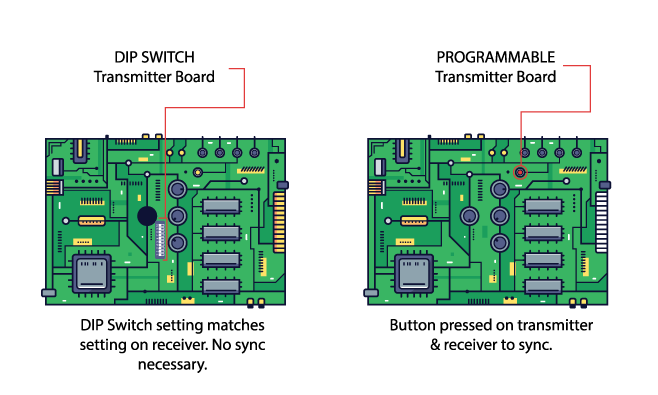
08 Apr DIP Switch vs. Programmable Transmitters: What’s the difference?
Technology, in the access control industry, moves at a much slower rate than other technology industries. DIP switch transmitters have been the go-to solution for simple access for decades. Programmable transmitters have come onto the market over the last decade and provide a more secure and robust access solution. So what’s the difference?

A DIP switch transmitter/receiver is a great solution for more simple access control. DIP switches operate by having a set of manual electric switches that are used on a printed circuit board which holds a configuration that matches a receiver. These types of transmitters are the cheapest access control devices because of their simplicity and the fact that there is almost no security to them except the screw that holds on the cover. The problem with DIP switches is if someone is able to figure out the switch settings on the receiver, they simply have to buy a transmitter and switch the transmitter to those settings. These switches are used for things like ranch gates, garage doors, or areas that do not require any information about who enters or exits.
One of the benefits of utilizing DIP switch technology is its ability to easily be set to match a receiver. Let’s say that a residential complex wants to install a gate where every resident has a transmitter. However, the complex doesn’t care to know exact information about who entered or when. A DIP switch transmitter and receiver would be a good option for this kind of situation. When ordering 500 transmitters, an extra $5 for a programmable transmitter adds up quickly. With these transmitters being much cheaper than programmable transmitters, it helps the apartment complex keep their costs low when a resident eventually loses, breaks, or doesn’t return it.
A programmable transmitter/receiver is a more secure and advanced option for access control. Programmable transmitters provide a more robust view of a secured area. A programmable transmitter synchronizes with the receiver and identifies itself through a unique code that is learned by the receiver. This unique code is specific to that transmitter and can’t be copied over to another device easily. The unique code of programmable devices makes the system more secure when compared to a DIP switch system because of its ability to track event logs, prevent mimicking the unique identifier, and more.
Event logs give a holistic view of who entered, when they opened the door/gate, and which door/gate they opened. Programmable devices are typically for more secured locations or for those clients that want to be able to segment access to protect certain assets.
A powerful security measure that programmable transmitters have is the ability to segment users and give them access to one area while denying them access to another. This is important in office buildings, schools, and other environments where access needs to be segmented based on personnel. This feature is available because of the ability to apply unique identifiers to each FOB or card that can’t be easily mimicked.
Both of these solutions have situations they work best for but for quick reference, programmable transmitters are for areas that need to be more secure and segmented while DIP switch solutions are designed for more binary enter/exit situations.
If you are looking for more information on what which solution would work best for your situation – reach out to us! Transmitter Solutions has trained professionals that have a deep knowledge of these technologies and love to help.



